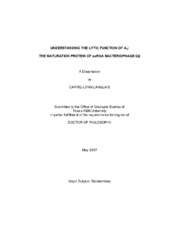| dc.description.abstract | Most bacteriophage escape the confines of the host bacterium by
compromising the integrity of its cell wall, an event that results in rupture (lysis)
of the cell. The lysis strategy of bacteriophage Qβ is inhibition of cell wall
biosynthesis while the cell is growing. To elicit lysis, the maturation protein (A2)
of Qβ inhibits the catalytic activity of MurA, an essential, induced fit enzyme in
the cell wall biosynthetic pathway. Consequent lysis releases progeny phage
into the environment.
The research in this dissertation addresses how lysis timing is integrated
into Qβ’s life cycle and discerns the molecular basis of the lytic event. Working
off the notion that, as displayed by the mature virion, A2 inhibits MurA, we
developed an in vivo bioassay to resolve the amount of inhibitory A2 during
infection. We found that the amount of free A2 is vastly greater than the amount
of virion-associated A2 and that both forms inhibit MurA. Additionally, the
amount of A2 correlates to lysis time and the burst size, as mutant Qβ with
upregulated expression of A2 (Qβpor) elicit host cell lysis faster and release fewer
mature virions than with the wildtype level of A2. This further suggests that
protection from Qβ lysis afforded by MurAL138Q is due to perturbed affinity between A2 and MurA. Yeast two-hybrid analysis supports that A2 and
MurAL138Q interact with weaker affinity by rendering small colonies compared to
yeast containing interacting A2-MurAwt. Scanning mutagenesis of MurA’s
surface near L138 identified residues that may be important for A2 contact in the
inhibitory complex. Potentially important residues map to a contiguous area on
the surface of MurA that spans both lobes on the flexible loop face of the
enzyme, suggesting that A2 prevents the induced fit mechanism of MurA in an
uncompetitive manner. Subsequent truncation analysis reveals that the aminoterminal
half of A2 is sufficient to mediate host cell lysis. Together, these
findings insinuate a model in which the amino-terminus of free A2 interacts with,
and inhibits MurA. Then, when the infected cell initiates division, septal
catastrophe ensues causing the cell to lyse and liberate progeny bacteriophage
Qβ. | en |


